There is nothing like the spice and color of Indian Chillies, especially those grown in the Guntur district of Andhra Pradesh. The crop is considered to be the most valuable in India. As well as being used in curries and chutneys, it is also used in vegetables, spices, condiments, sauces, and pickles. “Capsaicin,” an alkaloid, is responsible for the pungency of Chillies.
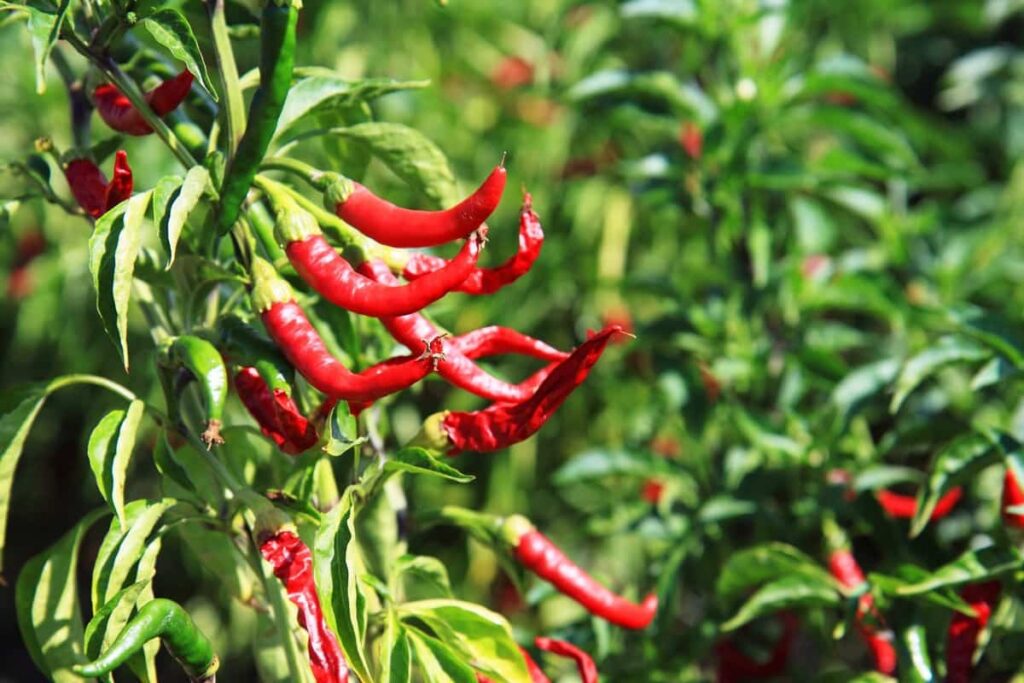
Indians began eating Chillies in the 17th century when the Portuguese introduced them in Goa. Chilli production is dominated by India, followed by China and Pakistan. The main states in which Chillies are grown are Andhra Pradesh, Maharashtra, Karnataka, Orissa, Tamil Nadu, Bihar, UP, and Rajasthan.
Growing Red Chilli organically in Andhrapradesh
Andhrapradesh government supports organic farming
PKVY (Paramparagat Krishi Vikas Yojana) and MOVCDNER (Mission Organic Value Chain Development for North Eastern Region) have promoted organic farming as chemical-free since 2015-16. As part of both schemes, organic farmers receive support from organic production, certification and marketing, and post-harvest management, such as packaging and processing.
In addition, farmers are provided financial assistance under the PKVY & MOVCDNER schemes for organic inputs such as seeds, bio-fertilizers, bio-pesticides, organic manure, compost/vermicompost, botanical extracts, etc. As a sub-scheme of Paramparagat Krishi Vikas Yojana (PKVY), Bhartiya Prakritik Krishi Padhati (BPKP) promotes traditional indigenous practices, such as Natural Farming (NF).
A major focus of the scheme is the exclusion of all synthetic chemicals. Furthermore, it promotes on-farm biomass recycling, focusing on biomass mulching, cow dung-urine formulations, and plant-based preparations. Financial assistance of Rs. 5000 per acre for three years is provided for cluster formation, capacity building, continuous handholding by trained personnel, and residue analysis as part of BPKP.
In case you missed it: High Yield Hybrid Chilli Varieties in India: For Rabi, Kharif, Winter, Summer, and Rainy Seasons
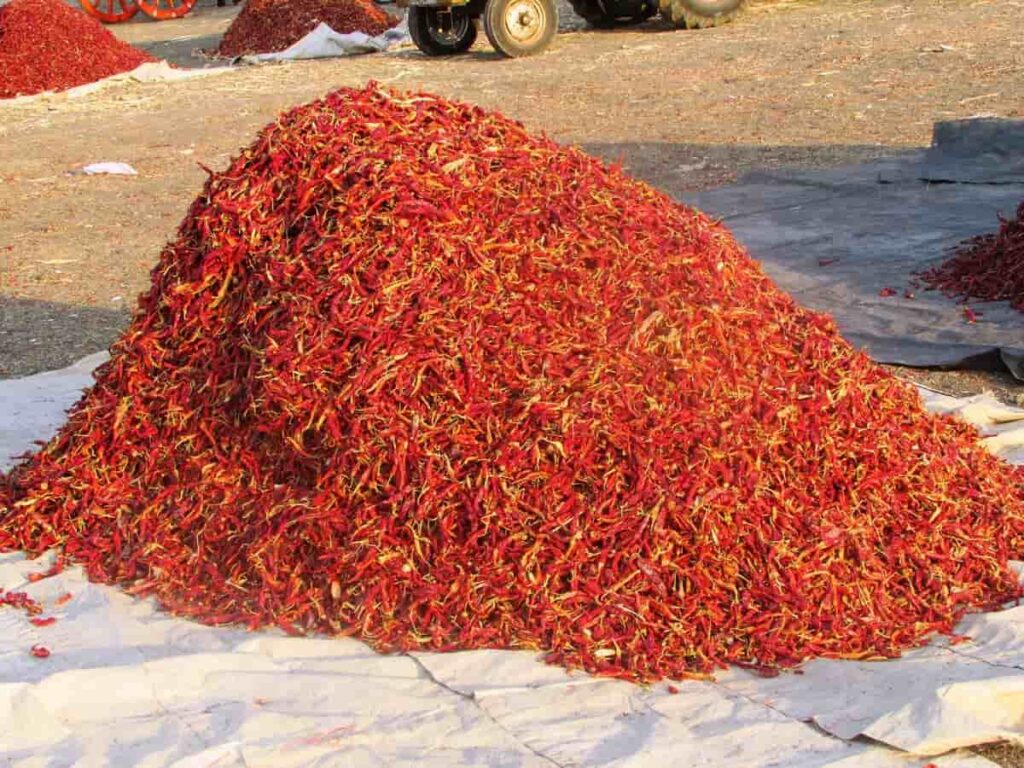
Climatic requirements for organic Chilli cultivation
Tropical and subtropical plants like Chillies require a combination of warm, humid, yet dry weather. Warm and humid weather is needed during the growth stage. The weather must be dry for fruit to mature, however. The range between 20⁰C-25⁰C is the ideal temperature range for Chilli growth. At 37⁰C or higher, crop development is affected.
Likewise, rotting begins when heavy rain falls on the plant. The buds do not develop properly when there is insufficient moisture during the fruiting period. It is, therefore, possible for flowers and fruit to fall off. In addition, it means that a high temperature and relatively low humidity level would cause deflowering, and fruits would be very small if they developed.
Soil requirement for organic Chilli cultivation
Moisture is necessary for the growth of Chillies. It is ideal if rainfed crops are grown on black soil, retaining moisture. A well-drained sandy loam with a high organic content is necessary for irrigated crops. Under irrigated conditions, they can also be grown in deltaic soil. During Chilli cultivation in Andhrapradesh, the soil is mixed with gravel and coarse sand. It is recommended that the pH of the soil be between 6.5 and 7.5 (neutral). Alkaline or acidic soils are not compatible with it.
Chilli varieties
Seeds are used to propagate Chillies. To cultivate healthy plants, it is necessary to choose disease-free seeds of good quality. Research institutes and organizations have developed several high-yielding, disease-resistant varieties. In the case of organic farming, the products must come from farms that are certified by a central authority. Chilli varieties used for commercial cultivation include:
Jwala
- Highly pungent variety with small
- The fruits have a red color.
- They are harvested from September to December.
- It is Grown in parts of Andhrapradesh and Gujarat.
Kanthari
- There is a high spice level in the short fruits.
- The color is ivory-white.
- Throughout the year, they can be grown as a homestead crop.
- Kerala, Tamil Nadu, and Andhra Pradesh are the states where it is grown.
In case you missed it: How to Grow Green Chilli Peppers Faster: Best Tips to Increase Flowering, Fruiting, and Production Yield
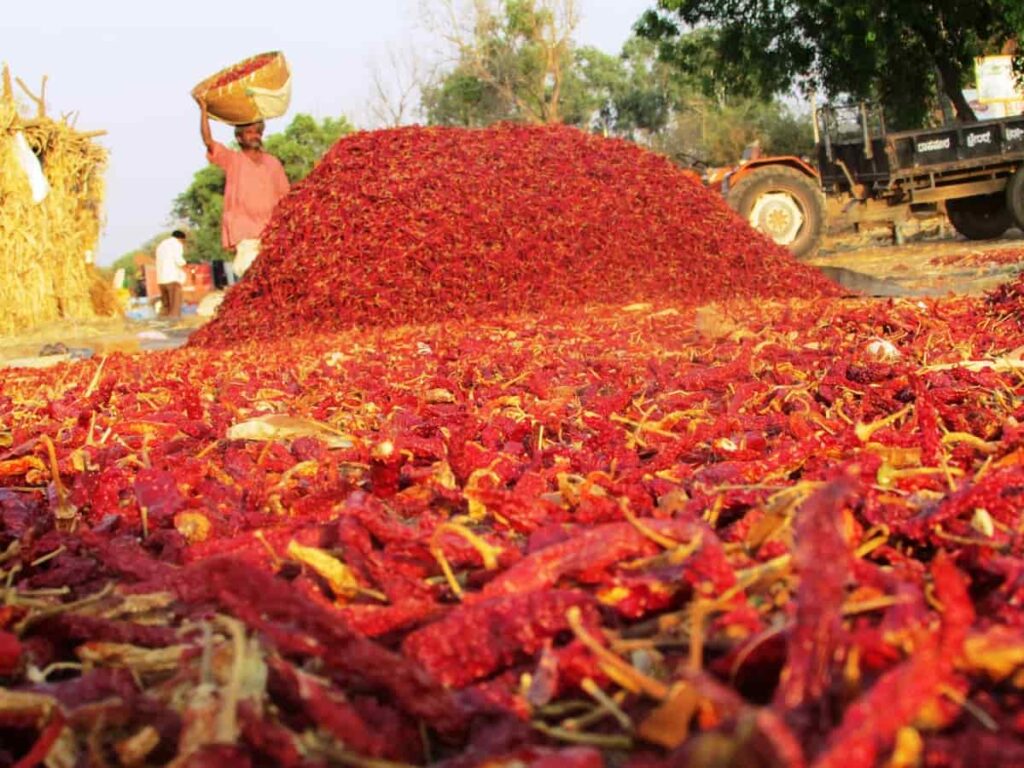
Bhagya Lakshmi
- G-4 is another name for it. Andhra Pradesh grows this variety in irrigated areas.
- Fruits are olive green when they are unripe and turn dark red when they are ripe.
- Pests and diseases are not a problem for this variety.
Hybrid Chilli Co1
- Fruits are 12 cm long, developed by TNAU, Coimbatore.
- A tapering point is at the tip of the raw fruit, which is light green.
- It is moderately resistant to fruit rot.
- Approximately 11 tonnes of green Chillies are produced per acre, and approximately 2 tonnes of dry pods are produced per acre.
- Within 200 days of a plantation, these Chillies are ready for harvest.
KI
- A pure line selection from Assam type B72A is used to develop it.
- In rainfed areas, they are suitable for cultivation.
- There are tall plants with many fruits on them.
- Approximately 700 kg of fruits is produced per acre by this variety.
PLR1
- Chillies of the Kandangadu type produce this variety.
- Fruits have a bulging base and are medium-sized.
- The tip of the Chillies appears dull, and they appear glossy.
- Pickling is the most common use for it.
- The crops are ready for harvest in 210 days and yield around 7 tonnes per acre.
Chilli farming seasons in Andhrapradesh
Chillies can be grown as a Kharif crop and a Rabi crop. Furthermore, they are also planted at other times of the year. However, it is important to note that Kharif crops are sown between May and June, while Rabi crops are sown between September and October. Therefore, as summer crops, it is best to plant them in January and February if they will be grown as summer crops.
Selection of planting material (seeds) for organic Chilli farming
The Chilli plant is propagated by seeds. To raise nurseries, seeds of high-yielding varieties resistant to pests and diseases should be used. It is vitally important to select the seeds from organic farms or their seed plots raised organically, certified organic farms. You can also use chemically untreated seeds from local high-yielding varieties if organic seeds are not available.
Bed preparation for seeds and sowing
The seeds of fresh Chillies are sown in well-prepared nursery beds. Although it can be sown by broadcast in the main field, transplanting is preferred to increase quality and survival. Nursery beds are typically raised from the ground and prepared with compost and sand. A thin layer of sand covers the seeds after they have been treated and sown. Germination takes between 5 and 7 days for the seed. Once the seedlings are about 40 – 45 days old, they are transplanted into the actual field.
In case you missed it: Best Practices to Grow Green Chilli (Mirchi): The Best Guide for Beginners
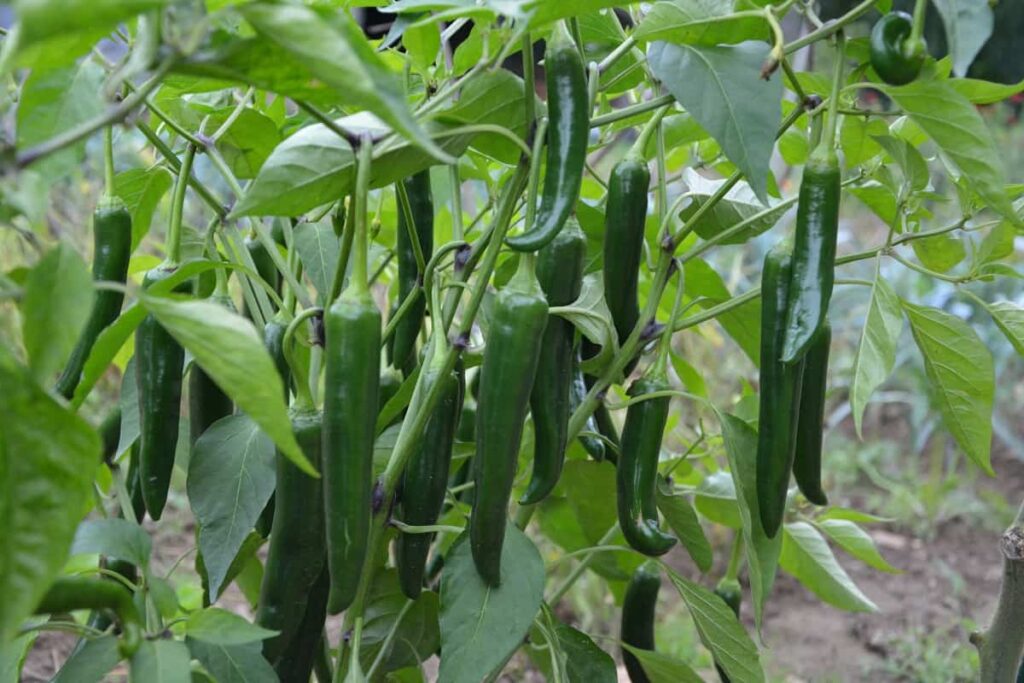
- Prepare the nursery area of 50 square meters with a slanting slope of 2 % for the seedling production to cover 1 acre.
- Cover the nursery area with a 50 % shade net and cover the sides using a 40/50 mesh insect-proof nylon net.
- Form raised beds of 1 m width and convenient length and place HDPV pipes at 2 m intervals for further protection with polythene sheets during rainy months.
- Mix sterilized cocopeat at 300 kg with 5 kg neem cake, Azospirillum, and phosphobacteria at 1 kg. Approximately 1.2 kg of cocopeat is required for filling one protray. In a paired row system with a spacing of 90 x 60 x 45 cm, 120 portrays (40 cells) are required to produce 11,500 to 12,000 seedlings.
- The treated seed should be sown in protrays with one seed per cell. The seeds needed to raise a nursery for transplantation on an acre would be 400 to 600 grams.
- The trays should be stacked one above the other, and a polythene sheet should be placed over the trays when germination begins.
- After six days, individually place the protrays with germinated seedlings on the raised beds inside the shade net.
- Water with rose can every day up to seed germination.
Land preparation for Chilli cultivation
Chillies farming requires plows to bring the land to a fine tilth 2-3 times. Afterward, gravel, stones, and other unwanted materials are removed from the soil. During the last plowing cycle, seeds sown directly in the soil are carried out. Plowing must, however, be done with sterilized soil so that diseases that affect plants can be prevented. Hybrids are cultivated with furrows separated by 60 cm x 45 cm and ridges separated by 75 cm x 60 cm. The distance between raised beds is 30 cm and the width is 120 cm.
Soil treatment for organic farming
- The soil is treated with Azotobacter or Azospirillum if Chillies are planted on an organic farm.
- Approximately 1 kilogram of Azotobacter or Azospirillum is mixed with 50 kilograms of farmyard manure.
- Vermicompost can also be added at a rate of 2 tonnes per acre.
Transplanting Chilli seedlings to the main field
Under rainfed conditions, it is transplanted mainly in June-July, and Chilli crops transplanted early in June have been found to escape the attack of thrips and mites in the Dharwad region. However, late-planted or with late varieties crop suffers less anthracnose fruit rot as the ripening of fruits is after the Sept-Oct rains. Therefore, around Andhrapradesh, July transplanted crop gives the maximum yield.
Water for organic Chilli cultivation
Chillies are crops that cannot resist a lot of water. Heavy rainfall and stagnated water would result in the rotting of the plants. In the case of irrigated crops, watering should be done only when it is necessary. Frequent watering would result in the shedding of flowers and a spurt of vegetative growth.
In case you missed it: Growing Onions Organically in Maharashtra: Cultivation Practices and Production Management

The amount of water to be irrigated, the number of irrigations, and their frequency highly depend on the climatic conditions and the soil type. If the leaves start drooping during the day, it indicates water requirement. If the flowers are weak, then irrigating the crop would be helpful. Some farmers irrigate the field once the soil moisture content falls below 25%.
Application of fertilizers in Chilli farming
Depending on the type of chili, the first flowers form 4 – 6 months after sowing. Before fertilizing, make sure that the soil is slightly moist. The roots will inevitably be damaged if the substrate is dry and watered with liquid fertilizer. Compost and horse manure are good organic fertilizers for Chillies grown organically.
Horse manure is spread on the vegetable bed and dug up. 100 kg of farm yard manure should be applied at the time of the last plowing of the nursery. Heavy application of organic manures is followed in irrigated areas. Usually, farm yard manure at 10-12 t/are is incorporated in the soil before transplanting. Mist bed compost has a good long-term effect as the components rot only slowly. During decomposition, the nutrient is first made accessible to the plants.
Weed control in organic Chilli farming
Weeds compete with the crop for soil moisture, nutrients, sunlight, and space, thus reducing the yield. Weed intensity is generally high in red soil than in black cotton soils. Higher weed intensity is noticed more in Kharif than in the rabi and summer seasons. The following weeds are known to harbor Chilli leaf curl causal organisms – Solanum nigrum, Acathospermum hispidum, Blainvillea rhumboidea, Flaverisa autralacica, and Ageratum conyzoide.
- Crop rotation involves alternating different crops systematically on the same land. It is an important strategy for developing a sound long-term weed control program.
- Rapid development and the dense ground covered by the crop will suppress weeds.
- Intercropping involves growing a smothered crop between rows of the main crop. Intercrops can suppress weeds.
- Mulching the soil surface can prevent weed seed germination by blocking light transmission, preventing seed germination.
Insect pest control in Chilli arming
Aphids, root grubs, thrips, mites, and pod borers are the main pests in Chilli farming. The field should only be fertilized with well-rotten farmyard manure to avoid infestation of root grubs. Controlling root grubs requires 100 kg of neem cake applied per acre. The agronomic practices also need to be changed to disrupt the grub’s life cycle. Root grub infestations can be controlled by laying out light traps from March onwards.
It is also helpful to transplant before the first fortnight of April to reduce the incidence of root grubs. The neem seed kernel extract can control thrips, aphids, and mites (NSKE). The kernels of 10 kg of neem seed can be boiled in 15 liters of water. This extract can be mixed with 15 liters of water and sprayed on sucking pests four to five times. Thrips and mites can also be controlled by releasing larvae of Chrysoperla cornea, a biocontrol agent.
There is considerable damage to the crop caused by fruit (pod) borers. Adopting bio control measures can be managed to a certain extent. Installing five pheromone traps per acre in the field helps monitor the adult moths. The spraying of neem products such as neem oil, neem seed kernel extract, and Bacillus thuringiensis at 0.4 kg/acre is beneficial. Inflorescences and shed fruits should be collected and destroyed regularly.
In case you missed it: Best Package Practices to Grow Chickpeas: Cultivation and Production of Bengal Gram/Chana
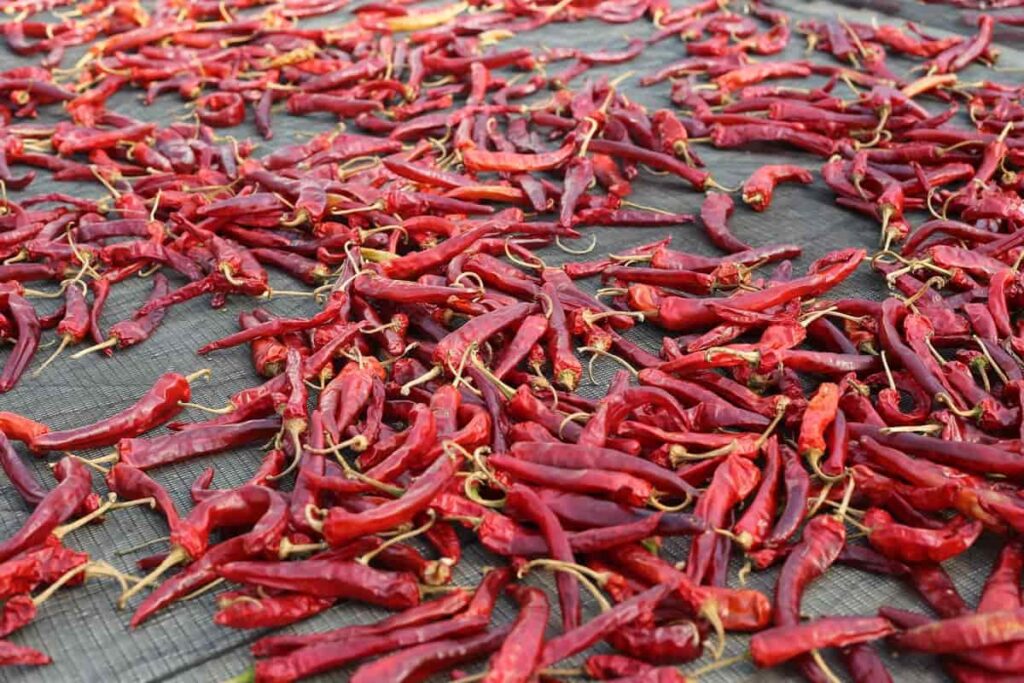
Disease control in Chilli farming
The two most common diseases in chilli farming are fruit rot and dieback caused by Colletotrichum capsici and bacterial wilt. The major diseases caused by viruses are bacterial leaf spots, powdery mildew, and mosaic disease. Chilli diseases can be controlled by selecting seeds carefully and adopting phytosanitary measures. In addition, the spread of diseases can be controlled by removing affected plants as soon as possible.
Trichoderma seed treatment prevents seedling rot in nurseries. It is recommended to use disease-tolerant varieties wherever the disease is severe. Getting rid of affected plants and destroying them helps stop the mosaic virus spread. Use 10 grams of Trichoderma or Pseudomonas sp per liter of water for effective disease control.
Harvesting and yield in Organic Chilli farming
There is a high perishability factor associated with Chillies. Therefore, this product’s harvest, storage, and transportation require more attention. It is important to harvest at the right stage of maturity. Chillies are generally harvested for vegetables while they are still green but fully grown. For canning purposes, chilies are harvested at the red stage.
A fully ripe chilli can be turned into chilli powder when it is harvested for drying. Yields vary depending on the cultivation system. It is estimated that the yield of dry chilis from rain-fed crops ranges from 200 to 400 kilograms per acre, while that from irrigated crops is 600 to 1000 kilograms per acre.
Conclusion
The cultivation of Chillies is a good business for vegetable farmers. India grows this crop largely for its fruits. However, as an intercrop or as a standalone plantation, Chilli crops can be grown. While chili is grown in many states, major Chilli-growing states include Andhra Pradesh, Telangana, Tamil Nadu, Karnataka, Maharashtra, Tamil Nadu, and West Bengal. If you live in the following districts of Andhra Pradesh (AP), this blog post will help you start growing organic Red Chilies.
| Konaseema | Pulivendula |
| Anakapalli | Kavali |
| East Godavari | Gudur |
| West Godavari | Kandukur |
| Srikakulam | Giddalur |
| Visakhapatnam/Vizag | Podili |
| Alluri Seetharam Raju | Addanki |
| Manyam | Chirala |
| Rajahmundry/Rajamahendravaram | Kanigiri |
| Narsapuram | Bobbili |
| Krishna | Ichapuram |
| Guntur | Rajam |
| Bapatla | Guntakal |
| Palnadu | Narsipatnam |
| Prakasam | Srisailam |
| Nellore | Bheemunipatnam |
| Kurnool | Attili |
| Kadapa | Butchireddipalem |
| Nandyal | Yelamanchili |
| Anantapur | Tuni |
| Chittoor | Jaggampeta |
| Tirupathi | Rajanagaram |
| Eluru | Mandapeta |
| Kakinada | Kadiam |
| Gannavaram | Venkatagirikota |
| Vijayawada/Bezawada | Kuppam |
| Narsaraopeta | Rajampet |
| Puttaparthy | Mydukur |
| Ongole | Gorantla |
| Vijayawada | Gooty |
| Rayachoty | Pedavegi |
| Tirupati | Unguturu |
| Machilipatnam | Denduluru |
| Bheemavaram | Koyyalagudem |
| Amalapuram | Nidadavole |
| Paderu | Akividu |
| Vizianagaram | Mogalthur |
| Parvathipuram | Bethamcherla |
| Adoni | Chintalapudi |
| Palakollu | Giddalur |
| Srikalahasti | Uravakonda |
| Mangalagiri | Banaganapalle |
| Kovvur | Vuyyuru |
| Amaravati | Lingapalem |
| Sullurupeta | Thallarevu |
| Madanapalle | Pedakakani |
| Tenali | Mangalagiri |
| Proddatur | Penamaluru |
| Sullurpeta | Macherla |
| Hindupur | Gollaprolu |
| Ravulapalem | Thondangi |
| Tadepalligudem | Kothapalli |
| Dharmavaram | Sakhinetipalle |
| Gudivada | Polavaram |
| Chilakaluripet | Ramachandrapuram |
| Tadipatri | Podili |
| Kadiri | Darsi |
| Markapuram | Nallajerla |
| Jaggayyapeta | Srungavarapukota |
| Nandigama | Payakaraopeta |
| Jangareddigudem | Anakapalle |
| Tanuku | Chodavaram |
| Kalyanadurgam | Kodumur |
| Dharmavaram | Pamur |
| Kuppam | Vetapalem |
| Repalle | Kalyandurgam |
| Vinukonda | Proddutur |
| Razole | Kodur |
| Kanchikacherla | and Paderu |
| Nuzvid | Naidupeta |
| Dhone | Atmakur |
| Allagadda | Kosigi |
| Rajampeta | and Ibrahimpatnam |
- How to Raise Pigs in Your Own Backyard: A Comprehensive Guide
- Budget Friendly Sheep Shed Ideas: Cheap and Low-Cost Tips
- How Much Do Cattle Farmers Make: Revenue Streams in Cattle Farming
- Management Pests and Diseases in Your Cotton Field
- Sheep Farming Business Plan for Beginners
- Aquaponic Farming at Home: A Step-By-Step Guide
- Profitable Village Farming Business Ideas in 2024
- High-Yield Aquaculture: Fast-Growing Fish for Farming
- Effective Fish Pond Construction Techniques for Beginners
- Irrigation and Water Management in Pineapple Farming
- Blossom to Harvest: Mastering Flowering and Pollination in Papaya Farming
- Pig Fattening Essentials: From Selection to Sale for Beginners
- Raising Wagyu Cattle: A Complete Guide for Premium Beef Production
- Soil Types and Their Water Holding Capacity
- Optimizing Irrigation Schedules for Coconut Groves for Enhanced Yield
- Espresso Your Garden: Coffee Grounds for Healthier Acid-Loving Plants
- The Best Soil Mix for Snake Plants: How to Mix Your Own Snake Plant Soil
- Green Thumb Success: Expert Tips for Cultivating Greenhouse Beans All Year Round
- Bloom All Year Round: The Ultimate Guide to Indoor Hyacinth Care
- Eco-Friendly Gardening: How to Make Liquid Fertilizer from Kitchen Waste
- Ultimate Guide to Grow Anise in Pots: Explore Seed Propagation to Harvesting
- Guide to Raising Chester White Pigs: Discover Breed Facts to Growth Management
- Mastering the Elegance: The Ultimate Guide to Weeping Cherry Tree Care, Planting, and Maintenance
- Ultimate Guide to Planting Garlic in Grow Bags: Growing Strategies for Beginners
- How to Fix Spider Plant Leaf-Related Problems: Natural and Organic Remedies
- 10 Reasons Why Your Tulsi Plant is Shedding Leaves: Home Remedies and Solutions
- Optimizing Growth and Yield: The Advantages of Palm Bunch Ash Fertilizer
- Utilizing Neem Oil Extract as a Natural Pesticide for Hydrangea
- From Soil to Harvest: Various Ways in Which Farmers Can Use AI Tools
- Steps to Encourage and Induce Citrus Flowers: A Comprehensive Guide
- How to Fix Snake Plant Leaf-Related Issues: Natural and Organic Remedies
- Transform Your Garden into a Fragrant Oasis with Raat Ki Rani (Night Blooming Jasmine)
- Discover the Ideal Chicken Breeds for Philippine Farms
- How to Create a Poultry Egg Farm Business Plan for Profits
- Grow Lemon Cucumbers Like a Pro: Insider Techniques for Bountiful Yields
- Ultimate Guide to Caring for Your Pink Princess Philodendron: Tips for Thriving Variegation
